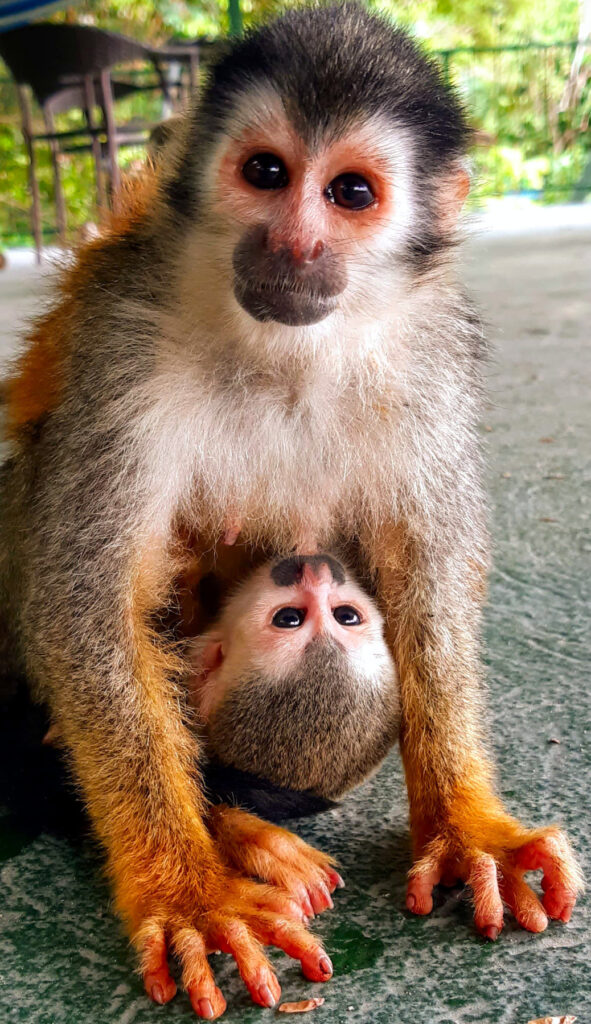
In the enchanting tropical realms of Quepos, Puntarenas, amidst the lush foliage and vibrant biodiversity, resides a captivating inhabitant—the Titi Monkey. This fascinating creature, scientifically known as Saimiri oerstedii, graces the verdant landscapes of Central and South America, adding an air of mystery to the intricate tapestry of the region’s diverse ecosystems.
Subspecies Symphony: Saimiri oerstedii oersted and Saimiri oerstedii citrinellus
Within the intricate dance of nature, the Titi Monkey takes center stage, existing as two distinct subspecies—Saimiri oerstedii oersted and Saimiri oerstedii citrinellus. Nature, in its wisdom, has allocated separate realms for these subspecies, with the former found in the Parrita area, Quepos, and the latter venturing southward to Puerto Jiménez. A defining characteristic sets them apart: the head color, grey for the Quepos resident and black for their counterparts in Puerto Jiménez. Despite these unique features, both subspecies face the looming threat of habitat destruction.
Physical Poetry: Unveiling the Titi Monkey’s Aesthetic
With elegance woven into their physicality, Titi Monkeys grace the forest with dimensions of 26 to 33 cm, tail included. The scales tip slightly heavier for the males, with a weight range of 1.5 to 1.1 kg, showcasing the gentle gender dichotomy. Akin to a living canvas, their golden backs merge seamlessly with a grey or black head. Delicate pink hands, adorned with soft, fleshy fingers, complement their grey legs and a belly that oscillates between white and grey.
Beyond Appearance: The Ecological Ballet of Titi Monkeys
In the ecological ballet of Quepos, Titi Monkeys orchestrate a symphony of significance. These arboreal beings navigate the forest canopies with grace, their communal foraging ventures forming groups of up to 75 individuals. Their omnivorous diet embraces fruits, plant materials, invertebrates, and small vertebrates—a testament to their adaptability in the face of a changing environment.
Social Harmony: Egalitarian Existence of Titi Monkey Tribes
In the intricate social structures of Titi Monkey tribes, egalitarianism reigns supreme. Females, devoid of dominance hierarchies, and males, asserting hierarchies solely during the breeding season, create a harmonious balance. Sexual maturity heralds independence for females at 2.5 years, while males may choose to remain with their natal group throughout their lives. Their communal existence unfolds under the watchful eye of potential predators, including raptors, cats, and snakes.
Conservation Odyssey: Navigating the Perils of Titi Monkeys
The Titi Monkey, a symbol of resilience, faces the daunting challenges of the modern world. Since the 1970s, a precipitous decline has gripped their populations. Deforestation, hunting, and the pet trade constitute the nefarious trifecta threatening their existence. Conservation efforts, fueled by the urgency to preserve biodiversity, are a beacon of hope, resonating the collective responsibility to protect these endangered beings.
In the Canopy’s Embrace: Where to Find Titi Monkeys in Quepos
Quepos, the sanctuary of biodiversity, hosts the Titi Monkey in its lowlands. These charismatic primates, though endangered, showcase adaptability, living and reproducing even in human-dominated areas. The conservation narrative is one of both challenges and triumphs, an ongoing odyssey to secure the future of this endangered species.
As dusk settles over the forest canopy in Quepos, the echoes of Titi Monkeys’ existence reverberate—a testament to the delicate balance maintained by these guardians of the treetops. In their continued survival, we find a reflection of nature’s resilience and a call to action for the preservation of Puntarenas’ unique and irreplaceable ecosystems.
